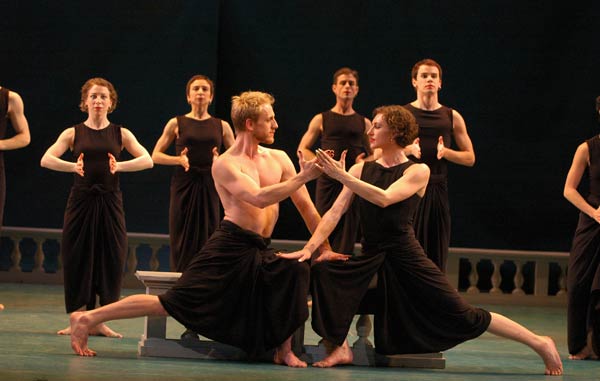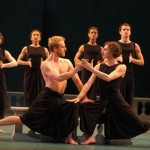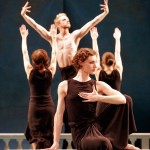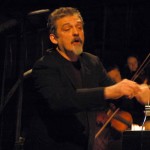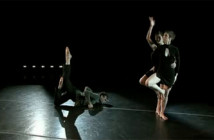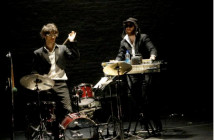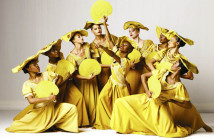By CHELSEY PHILPOT
When Mark Morris first staged his interpretation of the 17th century English opera “Dido and Aeneas,” what audience was he trying to reach? Did he intend to seduce opera aficionados with modern dance juxtaposed against familiar sounds? Was he meaning to introduce contemporary dance fanatics to the sensations opera creates with notes instead of bodies? Was he reaching out towards romantics? Or was he seeking to convert cynics with his choreography? Whatever his reasoning or whatever his purpose, in Morris’ interpretation of Henry Purcell’s opera love story, which itself was hijacked from Virgil’s “Aeneid,” the celebrated choreographer creates scenes of such power and beauty the memory of them lingers as long in the mind as the emotions do in the chest.
The Celebrity Series of Boston brought the Mark Morris Dance Group to Emerson’s Cutler Majestic Theater to perform “Dido and Aeneas” - a piece that premiered in 1989 in Brussels, for which they are well-known. Using Purcell’s original music sung by unseen singers, Morris tells the love story of Dido, the Queen of Carthage, and Aeneas, a Trojan explorer. Like all great love stories, this one ends in tragedy.
Dido’s friends slowly convince her to open her heart to the handsome Aeneas. (“Shake the cloud from off your brow; / Fate your wishes does allow; / Empire growing, pleasures flowing, / Fortune smiles and so should you.” her sister Belinda beseeches through her fluttering movements on stage as off stage a soprano sings.) Dido and Aeneas fall in love, but their fleeting bliss ends when an evil Sorceress and her witches trick Aeneas into betraying first himself and then Dido. After Aeneas offers to break a vow he made to the god Mercury, actually the Sorceress in disguise, Dido sends him away. She cannot believe his hypocrisy. She dies heartbroken. Her final plea to the world: “Remember me! But ah! forget my fate.”
Even with modern dance movements “Dido and Aeneas” is still an opera. It is dramatic, larger than life, unbelievable and yet gut wrenching at the same time. It is a performance that can be understood and felt as acutely by a season ticket holder as it can be by the student who had bought a half-priced ticket that afternoon. Morris’ choreography makes the lofty baroque music accessible. (not necessary, but an example here could help.)
When Morris first staged “Dido and Aeneas” he danced the part of both Dido and the Sorceress. However, he conducted Boston’s Emmanuel Music for this performance while the formidable Amber Darragh took on his former roles. Though the work’s title may be “Dido and Aeneas,” when it comes to the choreography, it should be called “Dido and the Chorus.” The chorus’ movements seemed to cue the collective gasps of the audience throughout.
On opening night, the majesty of the music and the cohesiveness of the Mark Morris Dance Group left no space for back-up dancers in “Dido and Aeneas.” The phalanx precision of the chorus left not one dancer in shadows, and did so without robbing the soloists of their moments to shine. Simply clad in black leotards and sarong-like skirts, the chorus dancers made their dignified movements both full of weight and yet weightless.
As a single force they moved around the simple set from pose to pose, consciously mimicking sculptures that their forms might have inspired had they danced in another era and place. When a soprano’s high voice emphasized the heavens, Morris had his chorus create angles with their knees and elbows and plant their feet firmly on the ground. When a voice warbled, the chorus of men and women wiggled their shoulders like tourists trying to move to Caribbean music, as if the music itself was holding them and making them shake back and forth. From time to time, Dido’s sister Belinda, danced by the petite and expressive Maile Okamura, and other characters would break free of the pack, but it was as a whole that the chorus had its greatest power.
Though the group movements created the spine of “Dido and Aeneas,” Darragh’s contribution must also be commended. With her curly brunette hair bound up she was Dido and her movements were majestic: the simple bend of a wrist, letting her long silver nails catch the light, gave her goddess like stature amongst the other dancers.. When Darragh switched to playing Dido’s enemy, the Sorceress, her wild hair hung free and she used her broad shoulders and height above the other dancers to dominate the stage.
Time may have made Morris’ “Dido and Aeneas” less radical than when his Group first staged it as the company-in-residence at Brussels’ Théâtre Royal de la Monnaie, but perhaps now it is to be appreciated even more. Yes, it is crazy that, with the Lowes Boston Common 19 just blocks away playing bad romantic comedies staring cynical, slacker love interests, a love story set to opera could be danced and believed, but the Mark Morris Dance Group and the musicians of Boston’s Emmanuel Music achieved this. Modern dance can tell a love story without irony or satire, and that’s what makes “Dido and Aeneas” not only timeless and accessible, but also radical indeed.
- Mark Morris Dance Group performing “Dido and Aeneas” Photo by Stephanie Berger
- “Dido and Aeneas” Mark Morris Dance Group. Photo by Beatriz Schiller
- Mark Morris conducting Photo by Stephanie Berger
Cutler Majestic Theatre at Emerson College - Mark Morris Dance Group
Mark Morris Dance Group performs Dido and Aeneas with the orchestra and chorus of Emmanuel Music 28 May - 1 June 2008 at Emerson's Cutler Majestic in the Celebrity Series of Boston.
- See more at: http://www.bigredandshiny.com/cgi-bin/BRS.cgi?section=review&issue=84&article=MARK_MORRIS_DANCE_584013#sthash.GTzcFf2e.dpuf

